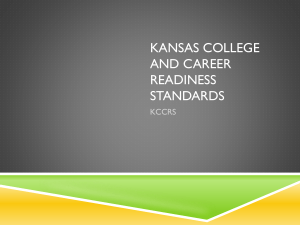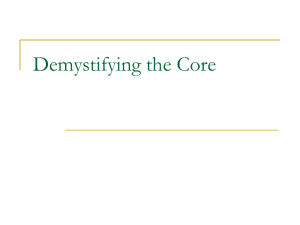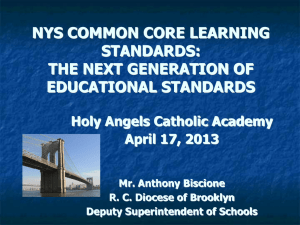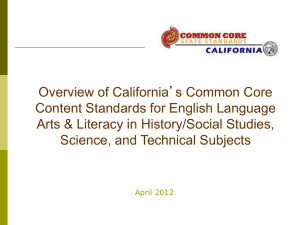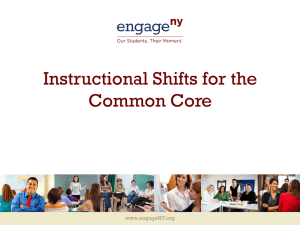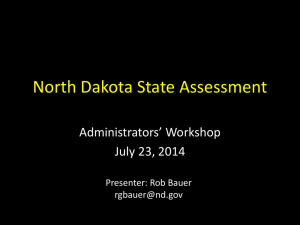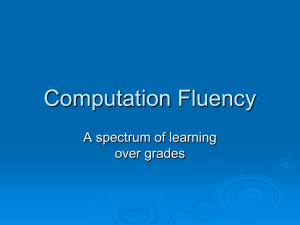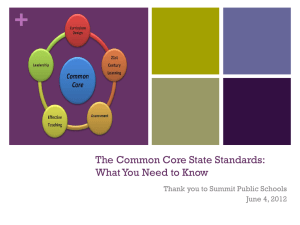Module 5 - Nassau BOCES
advertisement
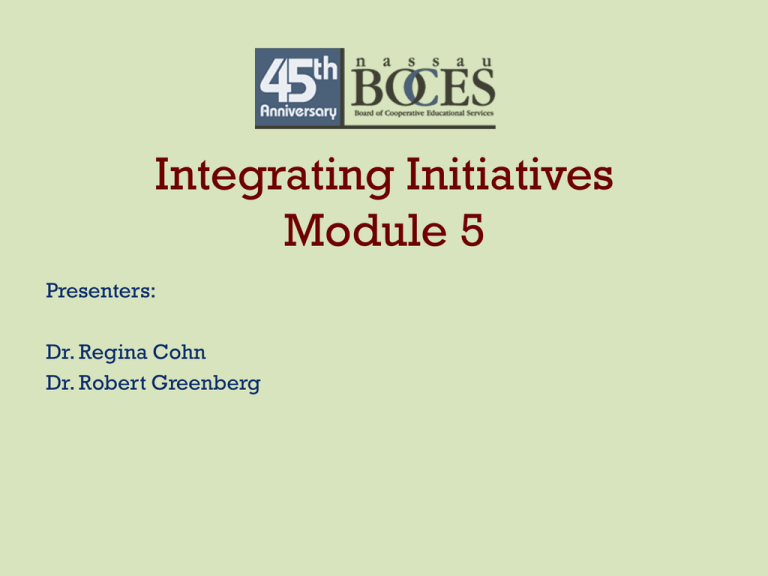
Integrating Initiatives Module 5 Presenters: Dr. Regina Cohn Dr. Robert Greenberg Activating Schema: Shifts in Practice 6 Shifts in ELA/Literacy Balancing Informational and Literary Text Building Knowledge in the Disciplines Staircase of Complexity Text-based Answers Writing from Sources Academic Vocabulary 6 Shifts in Mathematics Focus Coherence Fluency Deep Understanding Applications Dual Intensity 2 ELA/Literacy Shift 1: Balancing Informational and Literary Text What the Student Does… •Build content knowledge •Exposure to the world through reading What the Teacher Does… •Balance informational & literary text •Scaffold for informational texts •Apply strategies •Ask “What is connected?” 3 ELA/Literacy Shift 2: 6-12 Knowledge in the Disciplines What the Student Does… •Build content knowledge through text What the Teacher Does… •Shift identity: “I teach reading.” •Handle primary source documents •Stop referring and summarizing and start reading •Find Evidence •Slow down the history and science classroom 4 ELA Shifts 1 & 2 – Table Talk Popcorn Style: Name a non-fiction text you’ve recently seen a teacher using effectively 5 ELA/Literacy Shift 3: Staircase of Complexity What the Student Does… What the Teacher Does… •re-read •more complex texts at every grade level •read material at own level to enjoy reading •give students less to read, let them re-read •tolerate frustration •more time on more complex texts •provide scaffolding and strategies 6 ELA Shift 3 – Table Talk Think about a classroom where you’ve seen a teacher effectively teaching a grade level complex text. Popcorn Style: Share one teacher behavior that makes a close reading of a grade level complex text effective. 7 ELA/Literacy Shift 4: Text Based Answers What the Student Does… What the Teacher Does… •find evidence to support an argument •facilitate evidence-based conversations about text •form own judgments and become a scholar •plan and conduct rich conversations •keep students in the text •conduct reading as a close reading of the text •identify questions that are textdependent, worth asking about and •engage with the author exploring •spend much more time preparing for instruction by reading deeply 8 ELA/Literacy Shift 5: Writing from Sources What the Student Does… What the Teacher Does… •generate informational texts •spend much less time on personal narratives •make arguments using evidence •organize for persuasion •compare multiple sources •present opportunities to write from multiple sources •give opportunities to analyze, synthesize ideas. •develop students’ voice so that they can argue a point with evidence •give students permission to reach and articulate their own conclusions about what they read 9 ELA Shifts 5 & 6 – Table Talk In two sentences or less, share a recent example of students engaged in evidence based conversation or writing about text. 10 ELA/Literacy Shift 6: Academic Vocabulary What the Student Does… What the Teacher Does… •use high octane words across content areas •develop students’ ability to use and access words •build “language of power” database •be strategic about the new vocabulary words •work with words students will use frequently •teach fewer words using webs 11 Shift 6 – Table Talk In two sentences or less, share an example of innovative ways of embedding academic vocabulary and/or taking advantage of the ways students acquire vocabulary through reading. 12 Mathematics Shift 1: Focus What the Student Does… What the Teacher Does… •Spend more time on fewer concepts. •excise content from the curriculum •Focus instructional time on priority concepts •Give students the gift of time 13 Priorities in Math Grade K–2 3–5 6 7 8 Priorities in Support of Rich Instruction and Expectations of Fluency and Conceptual Understanding Addition and subtraction, measurement using whole number quantities Multiplication and division of whole numbers and fractions Ratios and proportional reasoning; early expressions and equations Ratios and proportional reasoning; arithmetic of rational numbers Linear algebra Math Shift 1 – Table Talk In two sentences or less, share a success story of a school, classroom, or grade level that has successfully conducted a “flab analysis” to protect instructional time for the priority standards. 15 Mathematics Shift 2: Coherence What the Student Does… What the Teacher Does… •Build on knowledge from year to year, in a coherent learning progression •Connect the threads of math focus areas across grade levels •connect to the way content was taught the year before and the years after •Focus on priority progressions 16 Mathematics Shift 3: Fluency What the Student Does… What the Teacher Does… •Spend time practicing, with intensity, skills (in high volume) •Push students to know basic skills at a greater level of fluency •Focus on the listed fluencies by grade level •Uses high quality problem sets, in high volume 17 Key Fluencies Grade Required Fluency K Add/subtract within 5 1 Add/subtract within 10 Add/subtract within 20 2 3 Add/subtract within 100 (pencil and paper) Multiply/divide within 100 Add/subtract within 1000 4 Add/subtract within 1,000,000 5 Multi-digit multiplication 6 Multi-digit division Multi-digit decimal operations 7 Solve px + q = r, p(x + q) = r 8 Solve simple 22 systems by inspection Math Shift 3 Raise your hand if you’ve seen fluency work in a classroom in the last month. 19 Mathematics Shift 4: Deep Understanding What the Student Does… What the Teacher Does… •Show mastery of material at a deep level •Create opportunities for students to understand the “answer” from a variety of access points •Articulate mathematical reasoning •demonstrate deep conceptual understanding of priority concepts •Ensure that EVERY student GETS IT before moving on •Get smarter in concepts being taught 20 Deep Conceptual Understanding In two sentences or less describe to your table mate moment where you watched a student reach deep conceptual understanding in Math. In two more sentences: what were the teacher moves that got the student there? 21 Mathematics Shift 5: Application What the Student Does… What the Teacher Does… •Apply math in other content areas and situations, as relevant •Apply math including areas where its not directly required (i.e. in science) •Choose the right math concept to solve a problem when not necessarily prompted to do so •Provide students with real world experiences and opportunities to apply what they have learned 22 Mathematics Shift 6: Dual Intensity What the Student Does… What the Teacher Does… •Practice math skills with an intensity that results in fluency •Find the dual intensity between understanding and practice within different periods or different units •Practice math concepts with an intensity that forces application in novel situations •Be ambitious in demands for fluency and practice, as well as the range of application 23 3 Initiatives Data Driven Instruction Teacher/ Leader Effectiveness College & Career Ready Students Common Core State Standards 24

